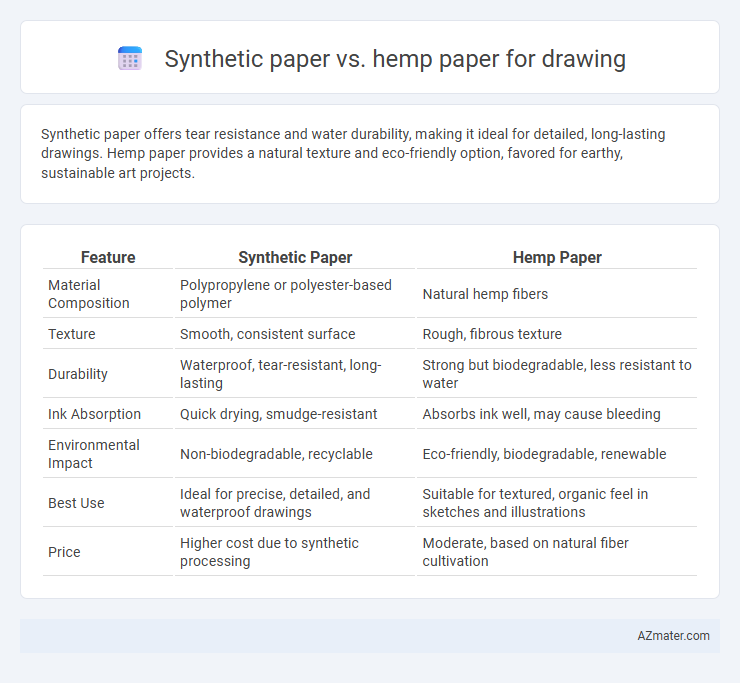Synthetic paper offers tear resistance and water durability, making it ideal for detailed, long-lasting drawings. Hemp paper provides a natural texture and eco-friendly option, favored for earthy, sustainable art projects.
Table of Comparison
| Feature | Synthetic Paper | Hemp Paper |
|---|---|---|
| Material Composition | Polypropylene or polyester-based polymer | Natural hemp fibers |
| Texture | Smooth, consistent surface | Rough, fibrous texture |
| Durability | Waterproof, tear-resistant, long-lasting | Strong but biodegradable, less resistant to water |
| Ink Absorption | Quick drying, smudge-resistant | Absorbs ink well, may cause bleeding |
| Environmental Impact | Non-biodegradable, recyclable | Eco-friendly, biodegradable, renewable |
| Best Use | Ideal for precise, detailed, and waterproof drawings | Suitable for textured, organic feel in sketches and illustrations |
| Price | Higher cost due to synthetic processing | Moderate, based on natural fiber cultivation |
Introduction: The Rise of Alternative Drawing Papers
Synthetic paper offers unparalleled durability and waterproof qualities, ideal for artists seeking longevity and vibrant colors. Hemp paper, derived from sustainable sources, appeals to environmentally conscious creators with its natural texture and strong fibers. Both alternatives challenge traditional wood-pulp paper by combining unique tactile experiences and ecological benefits for versatile artistic expression.
What Is Synthetic Paper?
Synthetic paper is a durable, waterproof material made from plastic resins such as polypropylene, designed to mimic the texture and feel of traditional paper while offering superior resistance to tearing and moisture. Its smooth surface allows for vibrant ink absorption and precise lines, making it ideal for detailed drawing and mixed media artwork. Unlike hemp paper, synthetic paper does not degrade easily and provides longevity, though it lacks the natural texture and eco-friendliness associated with hemp-based products.
Understanding Hemp Paper: Origins and Composition
Hemp paper, derived from the fibers of the Cannabis sativa plant, offers a durable and eco-friendly alternative to synthetic paper for drawing. Its high cellulose content provides a natural texture and superior ink absorption, enhancing detail and vibrancy in artwork. Understanding hemp paper's organic origins and composition highlights its sustainability advantages and unique tactile qualities compared to petroleum-based synthetic papers.
Surface Texture and Drawing Experience Comparison
Synthetic paper offers a smooth, consistent surface texture that enhances precision and allows various media like ink, markers, and graphite to glide effortlessly. Hemp paper presents a more textured, fibrous surface, providing tactile feedback that enhances grip but may create subtle resistance, ideal for charcoal and pastel work. Artists requiring fine detail and slick finishes often prefer synthetic paper, while those seeking natural texture and organic feel gravitate towards hemp paper for a richer drawing experience.
Ink and Medium Compatibility: Synthetic vs. Hemp
Synthetic paper offers superior ink absorption and resistance to bleeding, making it ideal for use with various inks, including markers, gel pens, and water-based mediums. Hemp paper has a more textured surface that can absorb ink unevenly, which may cause feathering or bleed-through, especially with liquid inks or heavy watercolor washes. Artists seeking smooth, consistent results with mixed mediums will find synthetic paper more reliable, while hemp paper suits those favoring natural fiber textures despite potential ink compatibility challenges.
Durability and Longevity: Which Paper Lasts Longer?
Synthetic paper offers exceptional durability and resistance to water, tearing, and fading, making it ideal for artworks requiring long-lasting preservation. Hemp paper, made from the fibers of the hemp plant, provides natural strength and is highly resistant to yellowing and deterioration over time due to its high cellulose content. For longevity in drawing applications, synthetic paper generally outperforms hemp paper by maintaining color vibrancy and structural integrity under various environmental conditions.
Environmental Impact: Sustainability Factors
Synthetic paper offers durability and water resistance but is largely derived from petroleum-based materials, raising concerns about non-biodegradability and carbon footprint. Hemp paper provides a sustainable alternative with rapid growth cycles, lower pesticide use, and full biodegradability, significantly reducing environmental impact. Its renewable nature and carbon sequestration capabilities make hemp paper a more eco-friendly option for artists seeking sustainable drawing materials.
Cost Analysis: Price Differences and Accessibility
Synthetic paper costs significantly more than hemp paper due to its plastic-based composition and specialized manufacturing processes, often priced between $20 to $40 per sheet depending on size. Hemp paper, derived from natural fibers, is generally more affordable, with prices ranging from $5 to $15 per sheet, benefiting from eco-friendly cultivation and growing market availability. Accessibility favors hemp paper as it is widely sold through art supply stores and online retailers, while synthetic paper remains niche with limited suppliers and higher shipping costs.
Artists’ Reviews: Feedback from the Drawing Community
Artists praise synthetic paper for its smooth texture and resistance to moisture, making it ideal for mixed media and detailed ink work. Hemp paper receives acclaim for its natural feel, durability, and eco-friendly properties, appealing to artists who prefer organic materials and a textured surface. Drawing community feedback highlights synthetic paper's versatility and hemp paper's sustainable appeal, influencing choices based on artistic style and environmental values.
Conclusion: Choosing the Right Paper for Your Artistic Needs
Synthetic paper offers durability, water resistance, and smooth texture ideal for mixed media and precision work, while hemp paper provides eco-friendly qualities with a natural texture suited for traditional and textured art styles. Artists prioritizing longevity and versatility may prefer synthetic paper, whereas those valuing sustainability and organic feel should consider hemp paper. Selecting the right paper depends on your artistic technique, environmental values, and desired finish for your artwork.

Infographic: Synthetic paper vs Hemp paper for Drawing
 azmater.com
azmater.com